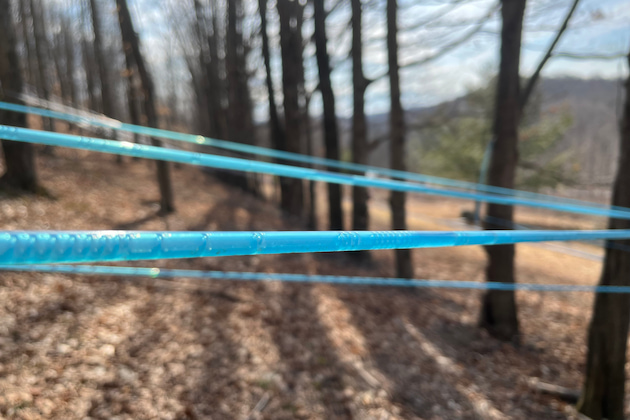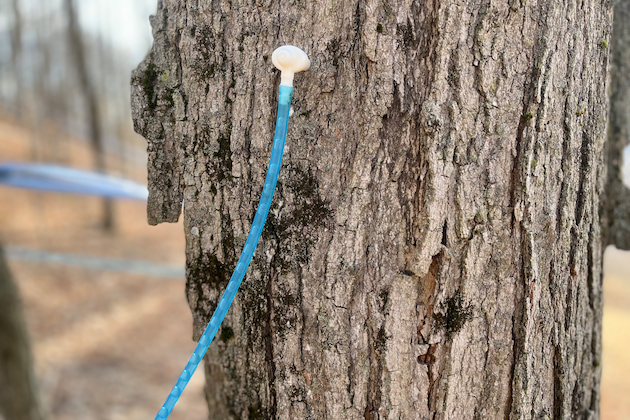Tapping & Tubing
Many sugarmakers sticking with 3/16 tubing
Not everyone is ripping it out
By PETER GREGG | MARCH 29, 2023
BOW, N.H.—The reputation of 3/16ths tubing has taken a beating the past couple of years, with sugarmakers gloriously ripping it out of their woods and declaring it a short lived fad.
But there are plenty of sugarmakers that have stuck with the natural vacuum technology, and say that it works for them, and is effective in getting high vacuum from gravity instead of a pump.
The key? Lots and lots of slope.
“Yes it seems the better the slope the better it works and less likely it is to plug up,” said Brandon Daniels of Daniels Pure Maple Syrup in Grassy Meadows, W.V.
Daniels is something of a 3/16ths guru in the Mountain State, where the narrow tubing still rules.
“We are blessed to be able to tap trees on eight properties and we have 2,500 taps on CDL 3/16 natural flow vacuum,” he said.
West Virginia has some of the steepest slope in the Maple Belt, which is why, anecdotally, the technology seems to work there.
Sugarmakers who have had trouble with plugging T’s and the dreaded “third year drop-off” may also have little slope to induce enough vacuum force to clear the lines.
At the Maple News Sugarhouse in Hebron, N.Y., extreme steep slope in many sections of the hillside keep the sap chugging through 3/16th tubing, and the “boxcar” bubbles of sap are visible to the naked eye rapidly descending down the pipeline, which is also hooked up to a vacuum pump—a so-called hybrid system, with 27.5 Hg most of the season.
“I am a hard line defender of 3/16ths tubing,” said Howard Boyden of Boyden Bros. Sugar House in Conway, Mass. where he has upwards of 3,000 taps all on 3/16ths on gravity.
“I’ve had it out for 11 years and it still works,” Boyden said. “I have a lot of gauges out in the woods that are pinned to 27 inches. We dont have plugging issues with our 3/16ths. We wash it, we use high quality tapping bits so no wood chips get into our spouts and we use check valves, which prevent against back flow.”
Boyden said another factor in making sure the tubing works is checking for leaks every day.
“You gotta have boots in the woods checking for squirrel chews,” Boyden said.
In Bow, N.H., sugarmaker Bruce Treat is also still a believer.
“I like 3/16 for my application and have used it for the last 8 years,” he told The Maple News. “ I have 8 small systems of between 80 to 140 taps, all with good slope. Two of my sugarbushes level off at the bottom and I feed the 3/16 lines into 1/2" to reach the tank. On the other 6, the 3/16 lines flow either directly into the tank or a shurflo pump.”
Treat also cleans his lines at the end of the season, utilizing the so-called Krueger Method, a cleaning process developed by legendary sugarmaker Art Krueger of Shrewsbury, Vt. who was a pioneer in 3/16th tubing technology. He developed a cleaning process that involved using swimming pool chemicals.
“ I replace spouts annually and load the lines with pool shock,” Treat said. “I had started replacing drops every three years, but have backed off finding that it hasn't been necessary.”
Few people have experimented with 3/16ths more than Steve Childs, the former director of the Cornell Maple Program in Van Etten, N.Y.
“I still believe 3/16 has a place in the maple system,” Childs told The Maple News. “On slopes it works great for gravity and with vacuum as well, as long as it is properly sanitized between seasons. I found it much easier to sanitize in place as it will hold the solution in place while in 5/16 the solution instantly runs to the lowest point making it hard to get the contact time I wanted.”

































